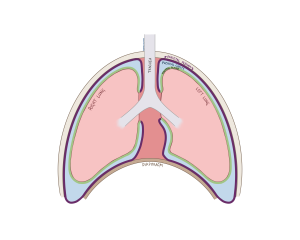55 Pleura
What are the pleura?
The pleura refers to two sets of membranes which line respiratory structures in the thoracic cage. Imagine punching your fist into a balloon without popping it. Just like the abdominal perineum, the pleura is like an inflated balloon which encompasses the lungs.
There are two sets of pleura:
- The parietal pleura is like the outer layer of the balloon (not touching your fist/ribcage), lines the inside of the thoracic cage, including the rib cage and diaphragm.
- The visceral pleura is like the inner layer of the balloon (directly touching your fist/lung) lines the outside of the lung.
Between the parietal and visceral pleura is the interpleural space which is crucial for maintaining different levels of pressure. The interpleural space also contains a small amount of serous fluid, which acts as a lubricant, allowing the pleural membranes to slide smoothly over each other without friction during respiration.

Figure 111 Anterior view of the pleura
When we breathe, a “negative pressure” is created which keeps the pleura from sticking together. Negative pressure is like a gentle suction. Think of using a straw to drink from a cup; as you take a sip, you create a negative pressure inside the straw which pulls the liquid up. Similarly, in your chest, the negative pressure helps pull the lungs outward, helping them stay open and expand when you inhale. This happens because the diaphragm moves downward and the pleura stretch outward, creating more space in the chest that the lungs can fill. Negative pressure within the lungs varies with breathing, ranging from –6 mmHg when you inhale to –2 mmHg when you exhale. However, if the pressure ever becomes 0 mmHg it can result in the lungs collapsing, which is quite dangerous.

